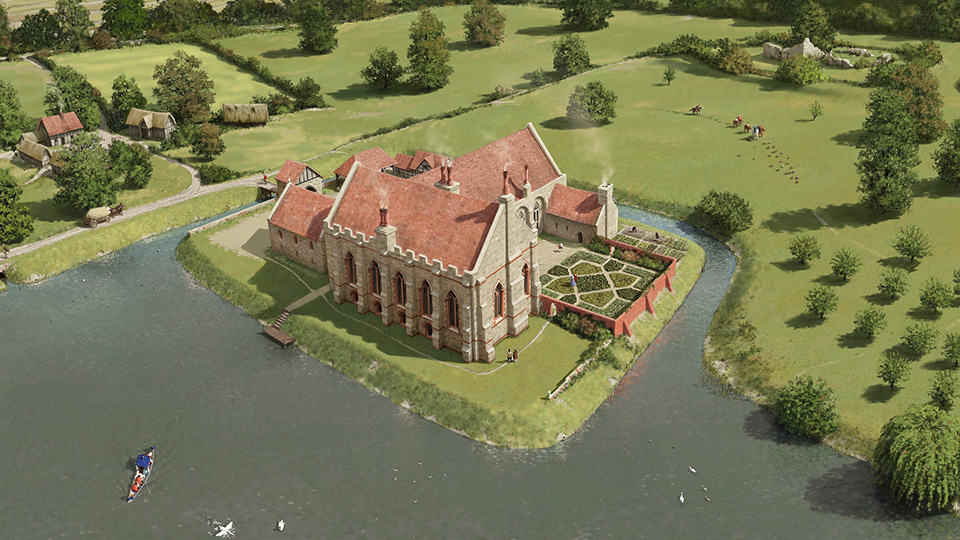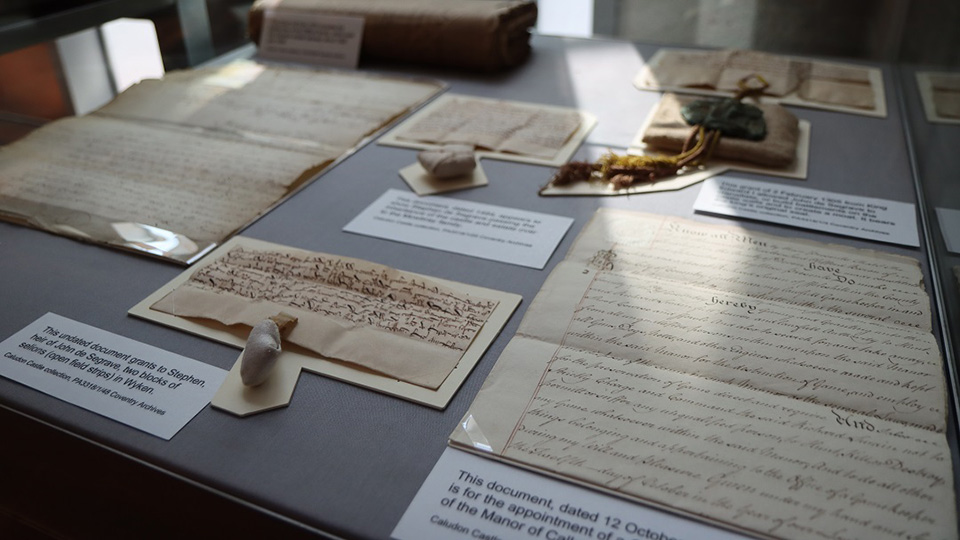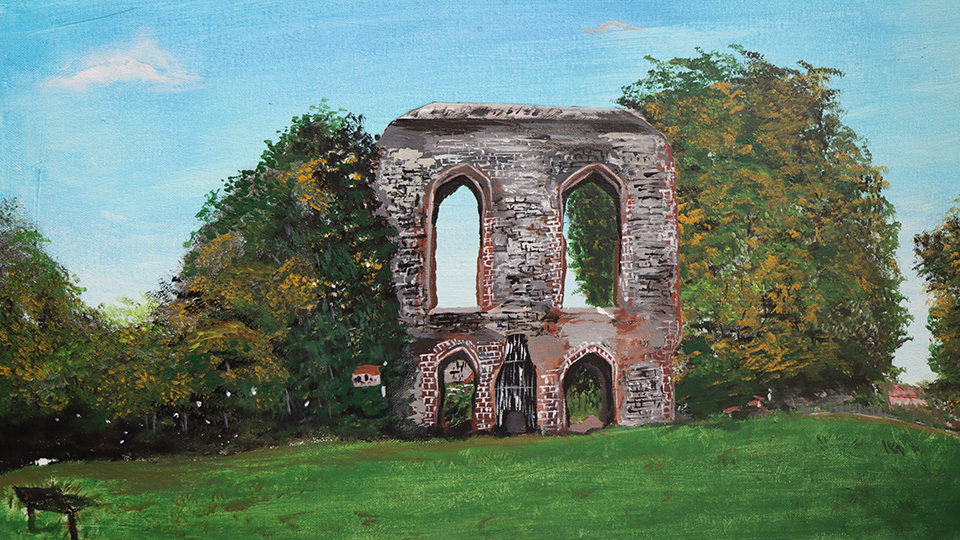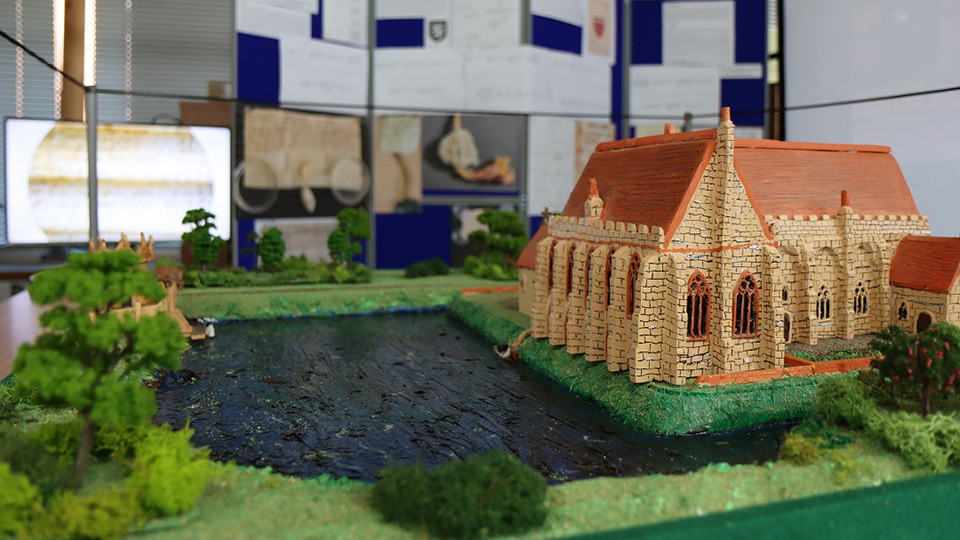Early Memories of a Lifelong Passion for Caludon Castle
29 April 2022

John Clarke OBE shares the story behind the Caludon Archive exhibition in our History Centre.
I spent my childhood just 150 yards from the ruin of old Caludon Castle, in its historic park which is the second oldest in the city after Cheylesmore with records going back to the early 1200s.
I first became fascinated with the history of the castle when I moved from Wyken Croft Junior School (where I was head boy) to Caludon Castle school, completely unaware of the castle’s history. However, the Lords of the Manor of Caludon together with their coats of arms and dates of ownership were hanging high above the windows in the school hall. On further investigation I was shown a brief handwritten history of the castle’s owners over a dozen pages in a scruffy green exercise book. This was the complete history of Caludon Castle at the time.
I was aged 13 and I set myself the task of learning more about the castle and one day writing a book. The rest as they say is history!
I had already drawn a picture of the castle at the tender age of 12 and this can be found in the inside sleeve of the dust cover of the book I eventually published on the history of Caludon in 2014 titled: A History of Caludon Castle: The Lords of the Manor of Caludon.
I maintained my interest in the castle’s history over many years and frequently added small pieces of information I had discovered – it was more of a hobby really – but as the years went by and more people (including my parents!) asked me when I was going to finish the book.
So, I decided to commission two experienced historians, Stephen Johnson and George Demidowciz, to assist me with research with the objective of getting the book published.
A major advantage was that Stephen had great experience in Manorial History and he was responsible for introducing me to Lord Clifford of Chudleigh in Devon – whose ancestors were Lords of the Manor of Caludon in the late 18th to mid-19th centuries. We discovered that Lord Clifford actually owned the historic archive relating to Caludon Castle’s aristocratic owners going back to the 1200s! Over 800 years of history – a treasure trove of documents including Royal Seals and signatures never seen before.

This find created a huge amount of research and I brought in George Demidowicz – formerly Conservation Officer for Coventry City Council – to take on the role as editor and co-author of my book. His vast experience and ability to read historic documents was a major bonus. My daughter Samantha, an ex-journalist with the Coventry Telegraph, was added to our team and her expert proof-reading skills were to become an important role in the completion of the book.
Even with this team the book took several more years and visits to Lord Clifford’s Muniments Room to research the hundreds of documents spread over 800 years.
During this period, George and I also organised a ‘resistivity survey’ of the Caludon Castle site – using electronic beams to identify the location and size of the original foundations beneath the ground. The result was quite incredible as the castle foundations of the existing Great Chambers, Great Hall, porch, kitchens, buttresses and other buildings showed a clear layout of the foundations just a few feet below the grass.
Using this layout of the foundations I then commissioned one of the leading historic artists in the country, Pete Urmston, who is regularly commissioned by English Heritage.
Using Cad Cam with the foundations discovered from the resistivity survey as well as contemporary design of buildings from the period, Pete constructed how Caludon would have looked in circa 1595 and his illustrations are published in my book.
Our research has thrown up so many revelations, but one of the most interesting is that we were able to confirm that could confirm that Caludon Castle was not besieged and demolished during the English Civil War, which has been the local legend for centuries! The house was actually demolished (apart from the existing wall of the Great Chambers) by the Cliffords in the late 18th century and a farmhouse called Caludon House built from the castle stonework in its place.

For centuries, Caludon Castle was the only nobleman’s residence in the Coventry area and has been owned by some of the most powerful families in the history of England, including the Seagraves, Mowbrays, Berkeleys and Cliffords.
My research for the book has revealed Caludon’s links with royalty and Shakespeare. Lord Henry Berkeley, Lord of the Manor of Caludon, was godson to King Henry VIII and his sons George and Thomas were godsons of Queen Elizabeth I. Thomas Mowbray, another Lord of Caludon, was Duke of Norfolk, Earl Marshall to the Sovereign and featured in Shakespeare’s Richard II.
Links with Shakespeare are well-documented – in addition to Thomas Mowbray and the aborted Battle of Gosford Green in Richard II, according to the British Library, Shakespeare is believed to have written A Midsummer Night’s Dream for the wedding of Thomas Berkeley (son of Lord Henry, Lord of Caludon) to Elizabeth Carey, grand-daughter of Lord Hunsdon, sponsor of Shakespeare’s acting troupe, the Lord Chamberlain’s Players. It is also argued that Shakespeare’s The Taming of the Shrew is based on the lives of Lord Henry and Lady Katherine Berkeley, Lord and Lady of the Manor of Caludon, who were both passionate about hunting, which is a key feature of the Bard’s play.
The exhibition now on display in the Herbert’s History Centre includes a mixture of original items and copies from the Caludon Archive, including the original Licence to crenelate (erect battlements) Caludon Castle and build a moat in 1305 with the seal of King Edward I and licence in Latin. Pride of place, however, must be the scale model of the castle (circa 1595) which was commissioned by myself and built by local modelmaker Pete Garbett.

Coventry Archives: Caludon Castle is on display in the History Centre until Saturday 21 May and is free to drop in with no booking required.
The History Centre is open 10.30am-3.30pm, Wednesday-Friday and alternating Saturdays.